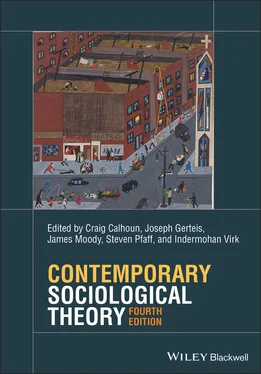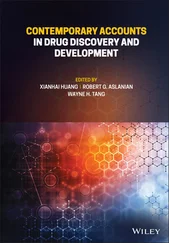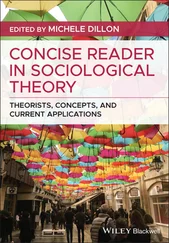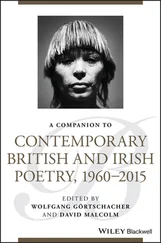Chapter 33
Jeffrey C. Alexander, pp. 3–9, 53–62, 64–67 from The Civil Sphere . Oxford University Press, 2006. Reproduced with permission of Oxford University Press.
Chapter 34
Michele Lamont, “Addressing Recognition Gaps: Destigmatization and the Reduction of Inequality,” pp. 420–436 from American Sociological Review 83: 3. Reproduced with permission of the author and American Sociological Association.
Chapter 35
Immanuel Wallerstein, “The Modern World-System in Crisis,” pp. 76–90 from World-Systems Analysis: An Introduction . Durham, NC: Duke University Press, 2004. Reproduced with permission of Duke University Press.
Chapter 36
Peggy Levitt and Nina Glick Schiller, “Conceptualizing Simultaneity: A Transnational Social Field Perspective on Society,” pp. 1002–1039 from International Migration Review 38: 3 (2004). Reproduced with permission of Sage Publications.
Chapter 37
Craig J. Calhoun, pp. 1, 3–7, 37, 39, 40, 42, 43, 66, 92–93, 94, 99, 103, 123, 125–126 from Nationalism . Open University Press, 1997. Reproduced with permission of McGraw-Hill Education (UK) Ltd.
Chapter 38
Michael Mann, “The End May Be Nigh, But For Whom?” pp. 71–76, 83–97 from Immanuel Wallerstein, Randall Collins, Michael Mann, Georgi Derluguian, Craig Calhoun, Does Capitalism Have a Future ? Oxford University Press, 2013. Reproduced with permission of Oxford University Press.
Sociology is the pursuit of systematic knowledge about social life, the way it is organized, how it changes, its creation in social action, and its disruption and renewal in social conflict. Sociological theory is at once an integrated account of what is known and a guide to new inquiry. It is organized scientifically to help us see the connections among different facts, relations of cause and effect, and deeper patterns of social organization and change.
But, sociological theory always comes in the form of multiple theories. Each offers a distinct perspective on society, helping us to see different dimensions of what is going on. Some difference is just a matter of focus, like looking at nature with a microscope or a telescope. Sociological theories may focus on interpersonal relations, large organizations like a corporation or an army, or overall patterns of social change and stability. But at any of these levels, sociological theories also propose different ways to look at social life.
The Classical Inheritance
Contemporary sociological theory is built on a foundation of classical theory laid down as part of Western modernization between the 18th century and the middle of the 20th century. These were remarkable but troubled years. They ran from the Enlightenment and industrial revolution through the rise of empires and then decolonization, the formation of the modern capitalist world system, two world wars, communist revolutions, Cold War, to the formation of welfare states that expanded health care, education, and other benefits. They included fantastic advances in technology, urbanization, and wealth. They also included the flourishing of the world’s first large-scale democratic societies – and long struggles to improve them because they were founded with internal contradictions, including toleration of slavery, exclusion of women, and restrictions on the rights of those without property.
Sociology was born of trying to understand all this transformation and upheaval – and also likely directions for further change and what action could shape the future of society. What we now call classical sociological theory is the most enduringly influential of this earlier work. Classical sociological theories orient us to several basic questions, revealing what is involved in different approaches to answering them. Among the most important are the following:
1 What are the conditions for scientific knowledge of social life?
2 How is society shaped by the state, and how in turn does society shape politics?
3 What are the social origins and impacts of markets, especially large and still expanding markets?
4 How do individuality, Community, and society relate to each other?
5 What are the fundamental differences among societies?
6 How have power relations among societies – such as colonialism and war – shaped individual societies and regional and global social relations?
All these questions remain active concerns for sociologists today. Sociological theories not only propose answers, but they also understand what counts as a good answer. They help us clarify basic concepts and their relations to each other. They help us develop the capacity for good judgment about what variables are likely to be important in a particular analytic problem or explanation. Even when they disagree with classical theories, contemporary sociologists measure their work by classical standards of intellectual quality.
Contemporary sociological theory has built on classical predecessors but sought both to go beyond them and to theorize new developments. Earlier theorists paid too little attention to race or to colonialism, for example. W.E.B. DuBois was an exception, showing the “problem of the color line” at work both in the racial division of the United States and in the global division shaped by European colonization. Not surprisingly, perhaps, most male theorists failed to appreciate the importance of both women’s inequality and gender as a constitutive social category. Classical theorists like Harriet Martineau and Jane Addams pointed to the issue, but men were slow to grasp it fully.
But, Du Bois, Martineau, and Addams were all clear that what they wanted was not to abandon classical sociological theory but rather to bring its analytic strengths to bear on issues it initially ignored or underestimated. Du Bois, for example, drew enthusiastically on the work of Max Weber and later Karl Marx. Martineau admired Spencer; Addams drew ideas of social evolution from the American sociologist Lester Frank Ward. What all wanted was to keep improving sociology’s intellectual inheritance and advance engagement with the key issues of their day.
What is “contemporary” of course keeps shifting. For Du Bois and Addams, the 19th century was classical, and the early 20th century was contemporary. For us, their work has become classical. Contemporary theory incorporates what is most valuable from its classical inheritance at the same time that it innovates, overcomes limits, and responds to new issues. Theorists ask, for example, whether the West is in decline or how it can renew itself.
We have drawn the line separating contemporary from classical roughly in 1968–1975. This was a period of crises and shifting directions. The year 1968 saw protest movements around the world, many sparked by the US war in Vietnam but also calling for broad social transformation. A million students marched through the streets of Paris and joined forces with as many as 10 million striking workers. In Japan as well as Europe and the United States, specific concerns of students mixed with pursuit of broader social transformation. Protests were huge in the United States, not just on college campuses but at the Chicago convention of the Democratic Party – where police repression became as famous as the protests.
Upheavals were international. Early in 1968, the Prague Spring briefly brought a progressive, potentially democratic government to Czechoslovakia before Soviet repression. Protests in Poland and Yugoslavia further signaled a crisis in the Communist bloc. Repression of dissent helped to bring stagnation that undermined communism over coming decades. 1973 brought a military coup in Chile that led to decades of right wing military dictatorship there (mirrored in some other Latin American countries). The dictators gave neoliberal economists some of their first chances to shape policy. Later in 1973, the Yom Kippur War helped to spark the transformation of OPEC into a global force controlling – and radically increasing – the price of oil. This sparked an economic crisis that famously combined high inflation with stagnant growth. Neoliberalism guided an intervention that tamed inflation but with policies that guided a long period when wealth grew but wages did not. The postwar boom ended, and inequality began to grow sharply.
Читать дальше












